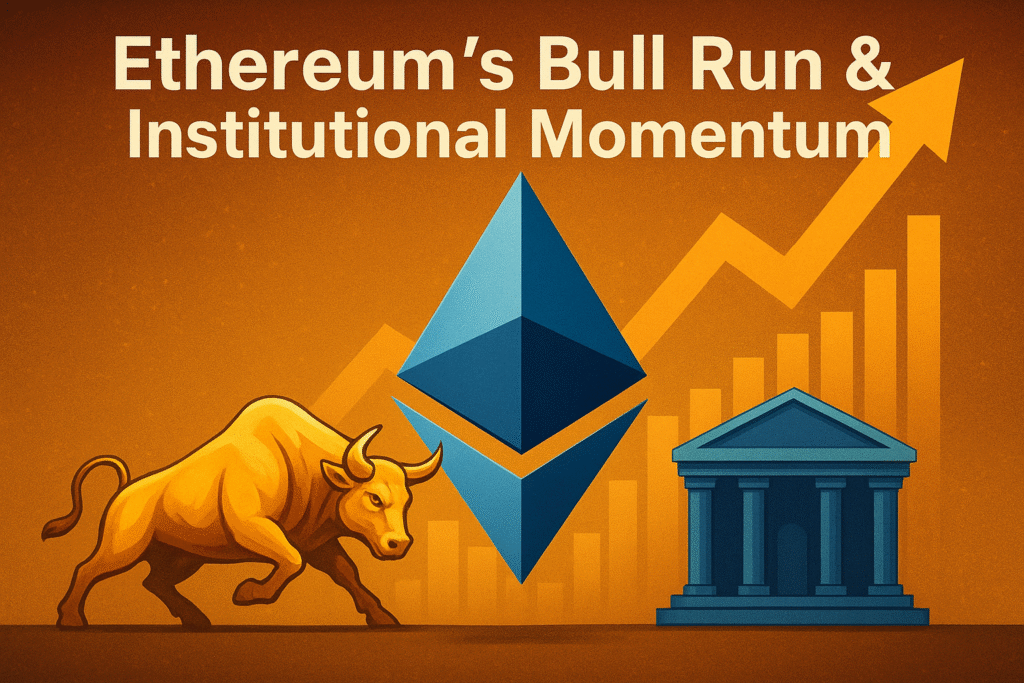The cryptocurrency market has long been defined by cycles of enthusiasm, correction, and innovation. In 2025, Ethereum is emerging as the centerpiece of a new rally, with its price trending toward levels many analysts believe could soon surpass $5,000. While past growth in the digital asset sector was often fueled by retail excitement and speculative trading, the current bull run is being shaped by something far more enduring: institutional momentum. From asset managers like BlackRock investing in Ethereum-based products to the continued development of Layer 2 solutions, the world’s second-largest cryptocurrency is proving it has both the technological foundation and financial backing to lead the next wave of blockchain adoption.
Why Ethereum Matters More Than Ever
Ethereum has always stood apart from other cryptocurrencies thanks to its versatility. Unlike Bitcoin, which primarily functions as a store of value, Ethereum serves as the foundation for decentralized applications, DeFi platforms, and NFT marketplaces. The introduction of smart contracts revolutionized blockchain by enabling programmable money and trustless agreements. In 2025, Ethereum continues to expand its relevance, especially in sectors like tokenized real-world assets, decentralized finance, and scalable enterprise-grade solutions.
One of the strongest indicators of Ethereum’s growing influence is its ability to attract institutional capital. Unlike earlier crypto cycles, where Ethereum was seen as a “high-risk altcoin,” today it is recognized as the backbone of Web3. Institutional investors are no longer asking whether Ethereum has staying power; instead, they are evaluating how to integrate it into diversified portfolios.
Institutional Confidence in Ethereum
The recent approval and launch of Ethereum exchange-traded funds (ETFs) have marked a turning point. Just as Bitcoin ETFs drove mainstream adoption and legitimized cryptocurrency as an asset class, Ethereum ETFs are providing a regulated, accessible entry point for both retail and institutional investors. BlackRock, Fidelity, and other asset managers have not only supported these products but have also begun allocating resources to Ethereum-related infrastructure.
This confidence is further underscored by Ethereum’s decreasing exchange reserves. Data shows that large holders, often referred to as whales, are moving their ETH off exchanges and into cold storage or staking contracts. This shift suggests that institutions and long-term investors believe in Ethereum’s price appreciation and are less interested in short-term trading.
The Role of Staking and Layer 2 Growth
Ethereum’s transition to proof-of-stake in 2022 laid the groundwork for its current institutional appeal. By allowing holders to stake their ETH and earn yield, Ethereum has positioned itself as both a growth asset and an income-generating instrument. Institutions, which thrive on predictable returns, see staking as a mechanism to participate in the network while benefiting from long-term appreciation.
Layer 2 networks like Arbitrum, Optimism, and zkSync are also playing a vital role in Ethereum’s expansion. These solutions provide faster, cheaper transactions while maintaining Ethereum’s security and decentralization. For institutions exploring real-world asset tokenization or decentralized financial products, scalability is critical. Ethereum’s ecosystem of Layer 2 networks offers a clear path to achieving mass adoption without sacrificing its foundational strengths.
The $5,000 Target and Beyond
Analysts are increasingly confident that Ethereum could surpass $5,000 within this cycle. This optimism is based not just on technical analysis but also on macroeconomic and regulatory trends. With the approval of crypto-focused legislation such as the GENIUS Act in the U.S. and MiCA in the European Union, regulatory clarity is creating a favorable environment for institutional entry. For Ethereum, this means greater acceptance as a legitimate financial instrument.
Furthermore, Ethereum’s narrative as the world’s decentralized computer is resonating with enterprises. Companies are exploring Ethereum for tokenization of real-world assets, decentralized supply chain management, and more efficient settlement systems. Each of these use cases adds real economic value, making Ethereum more than just a speculative asset.

Institutional Momentum: More Than Just Capital
It is important to note that institutional momentum is not just about money flowing into Ethereum. It also involves research, infrastructure, and influence. Large financial institutions are funding Ethereum research initiatives, developing custody solutions, and lobbying for favorable regulations. Their involvement helps reduce volatility while ensuring that Ethereum evolves in a way that aligns with broader financial markets.
For example, custodial services tailored for institutional investors now make it easier to securely store ETH. Payment providers and fintech firms are building Ethereum-based solutions that allow global settlement in seconds. Meanwhile, decentralized finance platforms are integrating compliance tools to attract traditional capital without losing their decentralized ethos.
Risks to Consider
While the outlook for Ethereum is bullish, investors should remain mindful of risks. Regulatory changes, network congestion, and potential competition from other Layer 1 blockchains like Solana or Avalanche could slow down growth. Additionally, unforeseen technological challenges could affect Ethereum’s scalability and transaction efficiency.
That said, Ethereum’s ability to continuously adapt has been one of its defining features. From the move to proof-of-stake to the explosion of decentralized applications, Ethereum has consistently proven resilient against challenges. As institutions enter the space, they bring resources that could help Ethereum overcome hurdles faster than ever before.
Conclusion: Ethereum’s Dual Strengths
Ethereum’s bull run in 2025 is different from previous cycles because it is backed by institutional momentum. The combination of capital inflows, regulatory clarity, and ongoing technological innovation is positioning Ethereum as the cornerstone of the blockchain economy. Unlike speculative rallies of the past, this growth is grounded in real-world use cases, from staking yields to the tokenization of assets.
Whether Ethereum reaches $5,000 this year or takes a longer path to that milestone, one thing is certain: institutional confidence has fundamentally reshaped the trajectory of the network. As enterprises, governments, and financial giants continue to build on Ethereum, its role in the global financial system will only deepen. For investors and innovators alike, Ethereum’s story is far from over—it is just entering a new, more mature chapter.
Leave a Reply